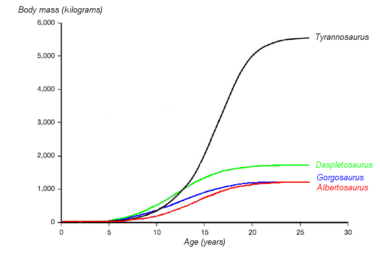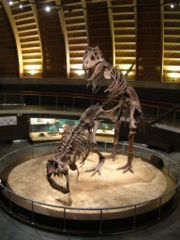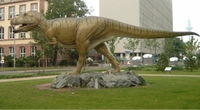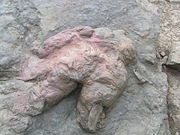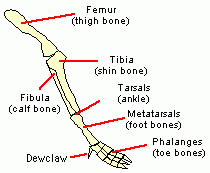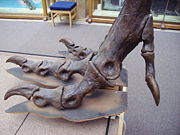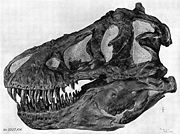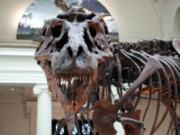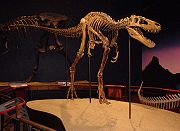Tyrannosaurus
2008/9 Schools Wikipedia Selection. Related subjects: Dinosaurs
| Tyrannosaurus Fossil range: Late Cretaceous |
||||||||||||||||||
|---|---|---|---|---|---|---|---|---|---|---|---|---|---|---|---|---|---|---|
 T. rex skull, Palais de la Découverte, Paris.
|
||||||||||||||||||
| Scientific classification | ||||||||||||||||||
|
||||||||||||||||||
| Species | ||||||||||||||||||
|
||||||||||||||||||
| Synonyms | ||||||||||||||||||
|
Tyrannosaurus (pronounced /tɨˌrænəˈsɔːrəs/ or /taɪˌrænoʊˈsɔːrəs/, meaning 'tyrant lizard') is a genus of theropod dinosaur. The famous species Tyrannosaurus rex ('rex' meaning 'king' in Latin), commonly abbreviated to T. rex, is a fixture in popular culture around the world. It lived throughout what is now western North America, with a much wider range than other tyrannosaurids. Fossils of T. rex are found in a variety of rock formations dating to the last three million years of the Cretaceous Period, approximately 68 to 65 million years ago; it was among the last non-avian dinosaurs to exist prior to the Cretaceous–Tertiary extinction event.
Like other tyrannosaurids, Tyrannosaurus was a bipedal carnivore with a massive skull balanced by a long, heavy tail. Relative to the large and powerful hindlimbs, Tyrannosaurus forelimbs were small, though unusually powerful for their size, and bore two primary digits, along with a possible third vestigial digit. Although other theropods rivaled or exceeded T. rex in size, it was the largest known tyrannosaurid and one of the largest known land predators, measuring up to 13 meters (43 ft) in length, up to 4 meters (13 ft) tall at the hips, and up to 6.8 metric tons (7.5 short tons) in weight. By far the largest carnivore in its environment, T. rex may have been an apex predator, preying upon hadrosaurs and ceratopsians, although some experts have suggested it was primarily a scavenger.
More than 30 specimens of T. rex have been identified, some of which are nearly complete skeletons. Soft tissue and proteins have been reported in at least one of these specimens. The abundance of fossil material has allowed significant research into many aspects of its biology, including life history and biomechanics. The feeding habits, physiology and potential speed of T. rex are a few subjects of debate. Its taxonomy is also controversial, with some scientists considering Tarbosaurus bataar from Asia to represent a second species of Tyrannosaurus and others maintaining Tarbosaurus as a separate genus. Several other genera of North American tyrannosaurids have also been synonymized with Tyrannosaurus.
Description
Tyrannosaurus rex was one of the largest land carnivores of all time; the largest complete specimen, FMNH PR2081 (" Sue"), measured 12.8 meters (42 feet) long, and was 4.0 meters (13 ft) tall at the hips. Mass estimates have varied widely over the years, from more than 7.2 metric tons (8 short tons), to less than 4.5 metric tons (5 tons), with most modern estimates ranging between 5.4 and 6.8 metric tons (between 6 and 7.5 tons). Although Tyrannosaurus rex was larger than the well known Jurassic theropod Allosaurus, it was slightly smaller than Cretaceous carnivores Spinosaurus and Giganotosaurus.
The neck of T. rex formed a natural S-shaped curve like that of other theropods, but was short and muscular to support the massive head. The forelimbs were long thought to bear only two digits, but there is an unpublished report of a third, vestigial digit in one specimen. In contrast the hind limbs were among the longest in proportion to body size of any theropod. The tail was heavy and long, sometimes containing over forty vertebrae, in order to balance the massive head and torso. To compensate for the immense bulk of the animal, many bones throughout the skeleton were hollow, reducing its weight without significant loss of strength.
The largest known T. rex skulls measure up to 1.5 meters (5 ft) in length. Large fenestrae (openings) in the skull reduced weight and provided areas for muscle attachment, as in all carnivorous theropods. But in other respects Tyrannosaurus’ skull was significantly different from those of large non- tyrannosauroid theropods. It was extremely wide at the rear but had a narrow snout, allowing unusually good binocular vision. The skull bones were massive and the nasals and some other bones were fused, preventing movement between them; but many were pneumatized (contained a "honeycomb" of tiny air spaces) which may have made the bones more flexible as well as lighter. These and other skull-strengthening features are part of the tyrannosaurid trend towards an increasingly powerful bite, which easily surpassed that of all non-tyrannosaurids. The tip of the upper jaw was U-shaped (most non-tyrannosauroid carnivores had V-shaped upper jaws), which increased the amount of tissue and bone a tyrannosaur could rip out with one bite, although it also increased the stresses on the front teeth.
The teeth of T. rex displayed marked heterodonty (differences in shape). The premaxillary teeth at the front of the upper jaw were closely-packed, D-shaped in cross-section, had reinforcing ridges on the rear surface, were incisiform (their tips were chisel-like blades) and curved backwards. The D-shaped cross-section, reinforcing ridges and backwards curve reduced the risk that the teeth would snap when Tyrannosaurus bit and pulled. The remaining teeth were robust, like "lethal bananas" rather than daggers, more widely spaced and also had reinforcing ridges. Those in the upper jaw were larger than those in all but the rear of the lower jaw. The largest found so far is estimated to have been 30 centimeters (12 in) long including the root when the animal was alive, making it the largest tooth of any carnivorous dinosaur.
Classification
Tyrannosaurus is the type genus of the superfamily Tyrannosauroidea, the family Tyrannosauridae, and the subfamily Tyrannosaurinae; in other words it is the standard by which paleontologists decide whether to include other species in the same group. Other members of the tyrannosaurine subfamily include the North American Daspletosaurus and the Asian Tarbosaurus, both of which have occasionally been synonymized with Tyrannosaurus. Tyrannosaurids were once commonly thought to be descendants of earlier large theropods such as megalosaurs and carnosaurs, although more recently they were reclassified with the generally smaller coelurosaurs.
In 1955, Soviet paleontologist Evgeny Maleev named a new species, Tyrannosaurus bataar, from Mongolia. By 1965, this species had been renamed Tarbosaurus bataar. Despite the renaming, many phylogenetic analyses have found Tarbosaurus bataar to be the sister taxon of Tyrannosaurus rex, and it has often been considered an Asian species of Tyrannosaurus. A recent redescription of the skull of Tarbosaurus bataar has shown that it was much narrower than that of Tyrannosaurus rex and that during a bite, the distribution of stress in the skull would have been very different, closer to that of Alioramus, another Asian tyrannosaur. A related cladistic analysis found that Alioramus, not Tyrannosaurus, was the sister taxon of Tarbosaurus, which, if true, would suggest that Tarbosaurus and Tyrannosaurus should remain separate.
Other tyrannosaurid fossils found in the same formations as T. rex were originally classified as separate taxa, including Aublysodon and Albertosaurus megagracilis, the latter being named Dinotyrannus megagracilis in 1995. However, these fossils are now universally considered to belong to juvenile T. rex. A small but nearly complete skull from Montana, 60 cm (2 ft) long, may be an exception. This skull was originally classified as a species of Gorgosaurus (G. lancensis) by Charles W. Gilmore in 1946, but was later referred to a new genus, Nanotyrannus. Opinions remain divided on the validity of N. lancensis. Many paleontologists consider the skull to belong to a juvenile T. rex. There are minor differences between the two species, including the higher number of teeth in N. lancensis, which lead some scientists to recommend keeping the two genera separate until further research or discoveries clarify the situation.
Manospondylus
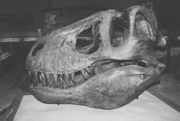
The first fossil specimen which can be attributed to Tyrannosaurus rex consists of two partial vertebrae (one of which has been lost) found by Edward Drinker Cope in 1892 and described as Manospondylus gigas. Osborn recognized the similarity between M. gigas and T. rex as early as 1917 but, due to the fragmentary nature of the Manospondylus vertebrae, he could not synonymize them conclusively.
In June 2000, the Black Hills Institute located the type locality of M. gigas in South Dakota and unearthed more tyrannosaur bones there. These were judged to represent further remains of the same individual, and to be identical to those of T. rex. According to the rules of the International Code of Zoological Nomenclature (ICZN), the system that governs the scientific naming of animals, Manospondylus gigas should therefore have priority over Tyrannosaurus rex, because it was named first. However, the Fourth Edition of the ICZN, which took effect on January 1, 2000, states that "the prevailing usage must be maintained" when "the senior synonym or homonym has not been used as a valid name after 1899" and "the junior synonym or homonym has been used for a particular taxon, as its presumed valid name, in at least 25 works, published by at least 10 authors in the immediately preceding 50 years…" Tyrannosaurus rex easily qualifies as the valid name under these conditions and would most likely be considered a nomen protectum ("protected name") under the ICZN if it was ever challenged, which it has not yet been. Manospondylus gigas would then be deemed a nomen oblitum ("forgotten name").
Paleobiology
Life history
The identification of several specimens as juvenile Tyrannosaurus rex has allowed scientists to document ontogenetic changes in the species, estimate the lifespan, and determine how quickly the animals would have grown. The smallest known individual ( LACM 28471, the "Jordan theropod") is estimated to have weighed only 29.9 kg (66 lb), while the largest, such as FMNH PR2081 (" Sue") most likely weighed over 5400 kg (6 short tons). Histologic analysis of T. rex bones showed LACM 28471 had aged only 2 years when it died, while "Sue" was 28 years old, an age which may have been close to the maximum for the species.
Histology has also allowed the age of other specimens to be determined. Growth curves can be developed when the ages of different specimens are plotted on a graph along with their mass. A T. rex growth curve is S-shaped, with juveniles remaining under 1800 kg (2 short tons) until approximately 14 years of age, when body size began to increase dramatically. During this rapid growth phase, a young T. rex would gain an average of 600 kg (1,300 lb) a year for the next four years. At 18 years of age, the curve plateaus again, indicating that growth slowed dramatically. For example, only 600 kg (1,300 lb) separated the 28-year-old "Sue" from a 22-year-old Canadian specimen ( RTMP 81.12.1). Another recent histological study performed by different workers corroborates these results, finding that rapid growth began to slow at around 16 years of age. This sudden change in growth rate may indicate physical maturity, a hypothesis which is supported by the discovery of medullary tissue in the femur of a 16 to 20-year-old T. rex from Montana ( MOR 1125, also known as "B-rex"). Medullary tissue is found only in female birds during ovulation, indicating that "B-rex" was of reproductive age. Further study indicates an age of 18 for this specimen. Other tyrannosaurids exhibit extremely similar growth curves, although with lower growth rates corresponding to their lower adult sizes.
Over half of the known T. rex specimens appear to have died within six years of reaching sexual maturity, a pattern which is also seen in other tyrannosaurs and in some large, long-lived birds and mammals today. These species are characterized by high infant mortality rates, followed by relatively low mortality among juveniles. Mortality increases again following sexual maturity, partly due to the stresses of reproduction. One study suggests that the rarity of juvenile T. rex fossils is due in part to low juvenile mortality rates; the animals were not dying in large numbers at these ages, and so were not often fossilized. However, this rarity may also be due to the incompleteness of the fossil record or to the bias of fossil collectors towards larger, more spectacular specimens.
Sexual dimorphism
As the number of specimens increased, scientists began to analyze the variation between individuals and discovered what appeared to be two distinct body types, or morphs, similarly to some other theropod species. As one of these morphs was more solidly built, it was termed the 'robust' morph while the other was termed ' gracile.' Several morphological differences associated with the two morphs were used to analyze sexual dimorphism in Tyrannosaurus rex, with the 'robust' morph usually suggested to be female. For example, the pelvis of several 'robust' specimens seemed to be wider, perhaps to allow the passage of eggs. It was also thought that the 'robust' morphology correlated with a reduced chevron on the first tail vertebra, also ostensibly to allow eggs to pass out of the reproductive tract, as had been erroneously reported for crocodiles.
In recent years, evidence for sexual dimorphism has been weakened. A 2005 study reported that previous claims of sexual dimorphism in crocodile chevron anatomy were in error, casting doubt on the existence of similar dimorphism between T. rex genders. A full-sized chevron was discovered on the first tail vertebra of "Sue," an extremely robust individual, indicating that this feature could not be used to differentiate the two morphs anyway. As T. rex specimens have been found from Saskatchewan to New Mexico, differences between individuals may be indicative of geographic variation rather than sexual dimorphism. The differences could also be age-related, with 'robust' individuals being older animals.
Only a single T. rex specimen has been conclusively shown to belong to a specific gender. Examination of "B-rex" demonstrated the preservation of soft tissue within several bones. Some of this tissue has been identified as medullary tissue, a specialized tissue grown only in modern birds as a source of calcium for the production of eggshell during ovulation. As only female birds lay eggs, medullary tissue is only found naturally in females, although males are capable of producing it when injected with female reproductive hormones like estrogen. This strongly suggests that "B-rex" was female, and that she died during ovulation. Recent research has shown that medullary tissue is never found in crocodiles, which are thought to be the closest living relatives of dinosaurs, aside from birds. The shared presence of medullary tissue in birds and theropod dinosaurs is further evidence of the close evolutionary relationship between the two.
Posture
Like many bipedal dinosaurs, Tyrannosaurus rex was historically depicted as a 'living tripod', with the body at 45 degrees or less from the vertical and the tail dragging along the ground, similar to a kangaroo. This concept dates from Joseph Leidy's 1865 reconstruction of Hadrosaurus, the first to depict a dinosaur in a bipedal posture. Henry Fairfield Osborn, former president of the American Museum of Natural History (AMNH) in New York City, who believed the creature stood upright, further reinforced the notion after unveiling the first complete T. rex skeleton in 1915. It stood in this upright pose for nearly a century, until it was dismantled in 1992. By 1970, scientists realized this pose was incorrect and could not have been maintained by a living animal, as it would have resulted in the dislocation or weakening of several joints, including the hips and the articulation between the head and the spinal column. Despite its inaccuracies, the AMNH mount inspired similar depictions in many films and paintings (such as Rudolph Zallinger's famous mural The Age Of Reptiles in Yale University's Peabody Museum of Natural History) until the 1990s, when films such as Jurassic Park introduced a more accurate posture to the general public. Modern representations in museums, art, and film show T. rex with its body approximately parallel to the ground and tail extended behind the body to balance the head.
Arms

When Tyrannosaurus rex was first discovered, the humerus was the only element of the forelimb known. For the initial mounted skeleton as seen by the public in 1915, Osborn substituted longer, three-fingered forelimbs like those of Allosaurus. However, a year earlier, Lawrence Lambe described the short, two-fingered forelimbs of the closely-related Gorgosaurus. This strongly suggested that T. rex had similar forelimbs, but this hypothesis was not confirmed until the first complete T. rex forelimbs were identified in 1989, belonging to MOR 555 (the "Wankel rex"). The remains of "Sue" also include complete forelimbs. T. rex 'arms' are very small relative to overall body size, measuring only one meter (3 ft) long. However, they are not vestigial but instead show large areas for muscle attachment, indicating considerable strength. This was recognized as early as 1906 by Osborn, who speculated that the forelimbs may have been used to grasp a mate during copulation. It has also been suggested that the forelimbs were used to assist the animal in rising from a prone position. Another possibility is that the forelimbs held struggling prey while it was dispatched by the tyrannosaur's enormous jaws. This hypothesis may be supported by biomechanical analysis. T. rex forelimb bones exhibit extremely thick cortical bone, indicating that they were developed to withstand heavy loads. The biceps brachii muscle of a full-grown Tyrannosaurus rex was capable of lifting 199 kg (438 lb) by itself; this number would only increase with other muscles (like the brachialis) acting in concert with the biceps. A T. rex forearm also had a reduced range of motion, with the shoulder and elbow joints allowing only 40 and 45 degrees of motion, respectively. In contrast, the same two joints in Deinonychus allow up to 88 and 130 degrees of motion, respectively, while a human arm can rotate 360 degrees at the shoulder and move through 165 degrees at the elbow. The heavy build of the arm bones, extreme strength of the muscles, and limited range of motion may indicate a system designed to hold fast despite the stresses of a struggling prey animal.
Soft tissue
In the March 2005 issue of Science, Mary Higby Schweitzer of North Carolina State University and colleagues announced the recovery of soft tissue from the marrow cavity of a fossilized leg bone, from a 68-million-year-old Tyrannosaurus. The bone had been intentionally, though reluctantly, broken for shipping and then not preserved in the normal manner, specifically because Schweitzer was hoping to test it for soft tissue. Designated as the Museum of the Rockies specimen 1125, or MOR 1125, the dinosaur was previously excavated from the Hell Creek Formation. Flexible, bifurcating blood vessels and fibrous but elastic bone matrix tissue were recognized. In addition, microstructures resembling blood cells were found inside the matrix and vessels. The structures bear resemblance to ostrich blood cells and vessels. Whether an unknown process, distinct from normal fossilization, preserved the material, or the material is original, the researchers do not know, and they are careful not to make any claims about preservation. If it is found to be original material, any surviving proteins may be used as a means of indirectly guessing some of the DNA content of the dinosaurs involved, because each protein is typically created by a specific gene. The absence of previous finds may merely be the result of people assuming preserved tissue was impossible, therefore simply not looking. Since the first, two more tyrannosaurs and a hadrosaur have also been found to have such tissue-like structures. Research on some of the tissues involved have suggested that birds are closer relatives to tyrannosaurs than other modern animals.
In studies reported in the journal Science in April 2007, Asara and colleagues concluded that seven traces of collagen proteins detected in purified T. rex bone most closely match those reported in chickens, followed by frogs and newts. The discovery of proteins from a creature tens of millions of years old, along with similar traces the team found in a mastodon bone at least 160,000 years old, upends the conventional view of fossils and may shift paleontologists' focus from bone hunting to biochemistry. Until these finds, most scientists presumed that fossilization replaced all living tissue with inert minerals. Paleontologist Hans Larsson of McGill University in Montreal, who was not part of the studies, called the finds "a milestone", and suggested that dinosaurs could "enter the field of molecular biology and really slingshot paleontology into the modern world."
Subsequent studies in April 2008 confirmed the close connection of T. rex to modern birds. Postdoctoral biology researcher Chris Organ at Harvard University announced, "With more data, they would probably be able to place T. rex on the evolutionary tree between alligators and chickens and ostriches." Co-author John M. Asara added, "We also show that it groups better with birds than modern reptiles, such as alligators and green anole lizards."
Skin
In 2004, the scientific journal Nature published a report describing an early tyrannosauroid, Dilong paradoxus, from the famous Yixian Formation of China. As with many other theropods discovered in the Yixian, the fossil skeleton was preserved with a coat of filamentous structures which are commonly recognized as the precursors of feathers. It has also been proposed that Tyrannosaurus and other closely-related tyrannosaurids had such protofeathers. However, rare skin impressions from adult tyrannosaurids in Canada and Mongolia show pebbly scales typical of other dinosaurs. While it is possible that protofeathers existed on parts of the body which have not been preserved, a lack of insulatory body covering is consistent with modern multi-ton mammals such as elephants, hippopotamus, and most species of rhinoceros. As an object increases in size, its ability to retain heat increases due to its decreasing surface area-to-volume ratio. Therefore, as large animals evolve in or disperse into warm climates, a coat of fur or feathers loses its selective advantage for thermal insulation and can instead become a disadvantage, as the insulation traps excess heat inside the body, possibly overheating the animal. Protofeathers may also have been secondarily lost during the evolution of large tyrannosaurids like Tyrannosaurus, especially in warm Cretaceous climates.
Thermoregulation
Tyrannosaurus, like most dinosaurs, was long thought to have an ectothermic ("cold-blooded") reptilian metabolism. The idea of dinosaur ectothermy was challenged by scientists like Robert Bakker and John Ostrom in the early years of the " Dinosaur Renaissance", beginning in the late 1960s. Tyrannosaurus rex itself was claimed to have been endothermic ("warm-blooded"), implying a very active lifestyle. Since then, several paleontologists have sought to determine the ability of Tyrannosaurus to regulate its body temperature. Histological evidence of high growth rates in young T. rex, comparable to those of mammals and birds, may support the hypothesis of a high metabolism. Growth curves indicate that, as in mammals and birds, T. rex growth was limited mostly to immature animals, rather than the indeterminate growth seen in most other vertebrates.
Oxygen isotope ratios in fossilized bone are sometimes used to determine the temperature at which the bone was deposited, as the ratio between certain isotopes correlates with temperature. In one specimen, the isotope ratios in bones from different parts of the body indicated a temperature difference of no more than 4 to 5 °C (7 to 9 °F) between the vertebrae of the torso and the tibia of the lower leg. This small temperature range between the body core and the extremities was claimed by paleontologist Reese Barrick and geochemist William Showers to indicate that T. rex maintained a constant internal body temperature ( homeothermy) and that it enjoyed a metabolism somewhere between ectothermic reptiles and endothermic mammals. Other scientists have pointed out that the ratio of oxygen isotopes in the fossils today does not necessarily represent the same ratio in the distant past, and may have been altered during or after fossilization ( diagenesis). Barrick and Showers have defended their conclusions in subsequent papers, finding similar results in another theropod dinosaur from a different continent and tens of millions of years earlier in time (Giganotosaurus). Ornithischian dinosaurs also showed evidence of homeothermy, while varanid lizards from the same formation did not. Even if Tyrannosaurus rex does exhibit evidence of homeothermy, it does not necessarily mean that it was endothermic. Such thermoregulation may also be explained by gigantothermy, as in some living sea turtles.
Footprints
Two isolated fossilized footprints have been tentatively assigned to Tyrannosaurus rex. The first was discovered in Philmont, New Mexico in 1983 by American geologist Charles Pillmore. Originally thought to belong to a hadrosaurid, examination of the footprint revealed a large 'heel' unknown in ornithopod dinosaur tracks, and traces of what may have been a hallux, the dewclaw-like fourth digit of the tyrannosaur foot. The footprint was published as the ichnogenus Tyrannosauripus pillmorei in 1994, by Martin Lockley and Adrian Hunt. Lockley and Hunt suggested that it was very likely the track was made by a Tyrannosaurus rex, which would make it the first known footprint from this species. The track was made in what was once a vegetated wetland mud flat. It measures 83 centimeters (33 in) long by 71 cm (28 in) wide.
A second footprint that may have been made by a Tyrannosaurus was first reported in 2007 by British paleontologist Phil Manning, from the Hell Creek Formation of Montana. This second track measures 76 cm (30 in) long, shorter than the track described by Lockley and Hunt. Whether or not the track was made by Tyrannosaurus is unclear, though Tyrannosaurus and Nanotyrannus are the only large theropods known to have existed in the Hell Creek Formation. Further study of the track (a full description has not yet been published) will compare the Montana track with the one found in New Mexico.
Locomotion
There are two main issues concerning the locomotory abilities of Tyrannosaurus: how well it could turn; and what its maximum straight-line speed was likely to have been. Both are relevant to the debate about whether it was a hunter or a scavenger (see below).
Tyrannosaurus may have been slow to turn, possibly taking one to two seconds to turn only 45° – an amount that humans, being vertically oriented and tail-less, can spin in a fraction of a second. The cause of the difficulty is rotational inertia, since much of Tyrannosaurus’ mass was some distance from its centre of gravity (like a human carrying a heavy timber) - although it might have reduced the average distance by arching its back and tail and pulling its head and forelimbs close to its body (rather like the way an ice skater pulls his or her arms closer in order to spin faster).
Scientists have produced a wide range of maximum speed estimates, mostly around 11 meters/second (25 mph), but a few as low as 5-11 meters/second (12-25 mph), and a few as high as 20 meters/second (45 mph). Researchers have to rely on various estimating techniques because, while there are many tracks of very large theropods walking, so far none have been found of very large theropods running - and this absence may indicate that they did not run. Scientists who think that Tyrannosaurus was able to run point out that hollow bones and other features that would have lightened its body may have kept adult weight to a mere 5 tons or so, or that other animals like ostriches and horses with long, flexible legs are able to achieve high speeds through slower but longer strides. Additionally, some have argued that Tyrannosaurus had relatively larger leg muscles than any animal alive today, which could have enabled fast running (40–70 km/h or 25–45 mph).
Jack Horner and Don Lessem argued in 1993 that Tyrannosaurus was slow and probably could not run (no airborne phase in mid-stride), because its ratio of femur (thigh bone) to tibia (shin bone) length was greater than 1, as in most large theropods and like a modern elephant. However, Holtz (1998) noted that tyrannosaurids and some closely related groups had significantly longer distal hindlimb components (shin plus foot plus toes) relative to the femur length than most other theropods), and that tyrannosaurids and their close relatives had a tightly interlocked metatarsus that more effectively transmitted locomotory forces from the foot to the lower leg than in earlier theropods ("metatarsus" means the foot bones, which function as part of the leg in digitigrade animals). He therefore concluded that tyrannosaurids and their close relatives were the fastest large theropods.
Christiansen (1998) estimated that the leg bones of Tyrannosaurus were not significantly stronger than those of elephants, which are relatively limited in their top speed and never actually run (there is no airborne phase), and hence proposed that the dinosaur's maximum speed would have been about 11 meters/second (about 24 mph), which is about the speed of a human sprinter. But he also noted that such estimates depend on many dubious assumptions.
Farlow and colleagues (1995) have argued that a 6-8 ton Tyrannosaurus would have been critically or even fatally injured if it had fallen while moving quickly, since its torso would have slammed into the ground at a deceleration of 6 g (six times the acceleration due to gravity, or about 60 meters/s²) and its tiny arms could not have reduced the impact. However, giraffes have been known to gallop at 50 km/h (31 mph), despite the risk that they might break a leg or worse, which can be fatal even in a "safe" environment such as a zoo. Thus it is quite possible that Tyrannosaurus also moved fast when necessary and had to accept such risks.
Most recent research on Tyrannosaurus locomotion does not narrow down speeds further than a range from 17 km/h (11 mph) to 40 km/h (25 mph), i.e. from walking or slow running to moderate-speed running. For example, a 2002 paper in the journal Nature used a mathematical model (validated by applying it to three living animals, alligators, chickens, and humans; additionally later eight more species including emus and ostriches) to gauge the leg muscle mass needed for fast running (over 40 km/h [25 mph]). They found that proposed top speeds in excess of 40 km/h (25 mph) were unfeasible, because they would require very large leg muscles (more than approximately 40–86% of total body mass.) Even moderately fast speeds would have required large leg muscles. This discussion is difficult to resolve, as it is unknown how large the leg muscles actually were in Tyrannosaurus. If they were smaller, only 18 km/h (~11 mph) walking/jogging might have been possible.
A study in 2007 used computer models to estimate running speeds, based on data taken directly from fossils, and claimed that T. rex had a top running speed of 8 meters per second (18 mph). An average professional football (soccer) player would be slightly slower, while a human sprinter can reach 12 m/s (27 mph). Note that these computer models predict a top speed of 17.8 m/second (about 45 mph) for a 3 kilogram (7 lb) Compsognathus (probably a juvenile individual).
Those who argue that Tyrannosaurus was incapable of running estimate the top speed of Tyrannosaurus at about 17 km/h (11 mph). This is still faster than its most likely prey species, hadrosaurids and ceratopsians. In addition, some advocates of the idea that Tyrannosaurus was a predator (see below) claim that tyrannosaur running speed is not important, since it may have been slow but still faster than its probable prey. However, Paul and Christiansen (2000) argued that at least the later ceratopsians had upright forelimbs and the larger species may have been as fast as rhinos. Healed Tyrannosaurus bite wounds on ceratopsian fossils are interpreted as evidence of attacks on living ceratopsians (see below). If the ceratopsians that lived alongside Tyrannosaurus were fast, that casts doubt on the argument that Tyrannosaurus did not have to be fast to catch its prey. Alternatively, perhaps Tyrannosaurus used ambush tactics to attack faster prey animals. The debate about Tyrannosaurus’ speed seems far from finished.
Feeding strategies
The debate about whether Tyrannosaurus was a predator or a pure scavenger is as old as the debate about its locomotion. Lambe (1917) described a good skeleton of Tyrannosaurus’ close relative Gorgosaurus and concluded that it and therefore also Tyrannosaurus was a pure scavenger, because the Gorgosaurus’ teeth showed hardly any wear. This argument is no longer taken seriously, because theropods replaced their teeth quite rapidly. Ever since the first discovery of Tyrannosaurus most scientists have agreed that it was a predator, although like modern large predators it would have been happy to scavenge or steal another predator's kill if it had the opportunity.
Noted hadrosaur expert Jack Horner is currently the major advocate of the idea that Tyrannosaurus was exclusively a scavenger and did not engage in active hunting at all. Horner has presented several arguments to support the pure scavenger hypothesis:

- Tyrannosaurs had large olfactory bulbs and olfactory nerves (relative to their brain size). These suggest a highly developed sense of smell which could sniff out carcasses over great distances, as modern vultures do. Opponents of the pure scavenger hypothesis have used the example of vultures in the opposite way, arguing that the scavenger hypothesis is implausible because the only modern pure scavengers are large gliding birds, which use their keen senses and energy-efficient gliding to cover vast areas economically. However, researchers from Glasgow concluded that an ecosystem as productive as the current Serengeti would provide sufficient carrion for a large theropod scavenger, although the theropod might have had to be cold-blooded in order to get more calories from carrion than it spent on foraging (see Warm-bloodedness of dinosaurs). They also suggested that modern ecosystems like Serengeti have no large terrestrial scavengers because gliding birds now do the job much more efficiently, while large theropods did not face competition for the scavenger ecological niche from gliding birds.
- Tyrannosaur teeth could crush bone, and therefore could extract as much food ( bone marrow) as possible from carcass remnants, usually the least nutritious parts. Karen Chin and colleagues have found bone fragments in coprolites (fossilized dung) that they attribute to tyrannosaurs, but point out that a tyrannosaur's teeth were not well adapted to systematically chewing bone like hyenas do to extract marrow.
- Since at least some of Tyrannosaurus's potential prey could move quickly, evidence that it walked instead of ran could indicate that it was a scavenger. On the other hand, recent analyses suggest that Tyrannosaurus, while slower than large modern terrestrial predators, may well have been fast enough to prey on large hadrosaurs and ceratopsians. It may also have used ambush tactics to attack faster prey animals.
Other evidence suggests hunting behaviour in Tyrannosaurus. Stevens (2006) found that the eye-sockets of tyrannosaurs are positioned so that the eyes would point forward, giving them binocular vision slightly better than that of modern hawks. He also pointed out that the tyrannosaur lineage had a history of steadily improving binocular vision. It is hard to see how natural selection would have favored this long-term trend if tyrannosaurs had been pure scavengers, which would not have needed the advanced depth perception that stereoscopic vision provides. In modern animals, binocular vision is found mainly in predators (the principal exceptions are primates, which need it for leaping from branch to branch).
At the site where the very large tyrannosaur named Sue was found, a skeleton of the hadrosaurid Edmontosaurus annectens was also found, with healed tyrannosaur-inflicted damage on its tail vertebrae. The fact that the damage seems to have healed suggests that the Edmontosaurus survived a tyrannosaur's attack on a living target, i.e. the tyrannosaur had attempted active predation. A Triceratops was found in Mexico found with bite marks on its ilium. These were also inflicted by a tyrannosaur and they too appear healed, indicating active predation by the tyrannosaur. Tyrannosaurus also had a bite force estimated at 6,400 to 13,400 N, rivaling any other known taxon. However, further recent investigation of these purported wounds has shown that most are infections rather than injuries (or simply damage to the fossil after death) and the few injuries are too general to be indicative of intraspecific conflict.
Some researchers argue that if Tyrannosaurus were a scavenger, another dinosaur had to be the top predator in the Amerasian Upper Cretaceous. Top prey were the larger marginocephalians and ornithopods. The other tyrannosaurids share so many characteristics that only small dromaeosaurs remain as feasible top predators. In this light, scavenger hypothesis adherents have suggested that the size and power of tyrannosaurs allowed them to steal kills from smaller predators. Most paleontologist accept that Tyrannosaurus was both an active predator and a scavenger.
History
Henry Fairfield Osborn, president of the American Museum of Natural History, named Tyrannosaurus rex in 1905. The generic name is derived from the Greek words τυραννος (tyrannos, meaning "tyrant") and σαυρος (sauros, meaning "lizard"). Osborn used the Latin word rex, meaning "king", for the specific name. The full binomial therefore translates to "tyrant lizard king," emphasizing the animal's size and perceived dominance over other species of the time.
Earliest finds
Teeth from what is now documented as a T. rex were found in 1874 by A. Lakes near Golden, Colorado. In the early 1890s, J. B. Hatcher collected postcranial elements in eastern Wyoming. The fossils were believed to be from a large species of Ornithomimus (O. grandis) but are now considered T. rex. Vertebral fragments found by E. D. Cope in western South Dakota in 1892 and named as Manospondylus gigas have also been reclassified as T. rex.
Barnum Brown, assistant curator of the American Museum of Natural History, found the first partial skeleton of T. rex in eastern Wyoming in 1900. H. F. Osborn originally named this skeleton Dynamosaurus imperiosus in a paper in 1905. Brown found another partial skeleton in the Hell Creek Formation in Montana in 1902. Osborn used this holotype to describe Tyrannosaurus rex in the same paper in which D. imperiosus was described. Had it not been for page order, Dynamosaurus would have become the official name. The original Dynamosaurus material resides in the collections of the Natural History Museum, London.
In total, Brown found five Tyrannosaurus partial skeletons. In 1941, Brown's 1902 find was sold to the Carnegie Museum of Natural History in Pittsburgh, Pennsylvania. Brown's fourth and largest find, also from Hell Creek, is on display in the American Museum of Natural History in New York.
Although there are numerous skeletons in the world, only one track has been documented — at Philmont Scout Ranch in northeast New Mexico. It was discovered in 1983 and identified and documented in 1994.
Notable specimens
Sue Hendrickson, amateur paleontologist, discovered the most complete (more than 90%) and, until 2001 the largest, Tyrannosaurus fossil skeleton known in the Hell Creek Formation near Faith, South Dakota, on August 12, 1990. This Tyrannosaurus, nicknamed "Sue" in her honor, was the object of a legal battle over its ownership. In 1997 this was settled in favour of Maurice Williams, the original land owner, and the fossil collection was sold at auction for USD 7.6 million, making it the most expensive dinosaur skeleton to date. It has now been reassembled and is currently exhibited at the Field Museum of Natural History. A study of this specimen's fossilized bones showed that "Sue" reached full size at age 19 and died at age 28, the longest any tyrannosaur is known to have lived. The "Sue" specimen apparently died from a massive bite to the head, which could only have been inflicted by another tyrannosaur. Researchers reported that a subadult and a juvenile skeleton were found in the same quarry as the "Sue" specimen, which has been used to support the hypothesis that tyrannosaurs may have lived in social groups of some kind.
Another Tyrannosaurus, nicknamed "Stan", in honour of amateur paleontologist Stan Sacrison, was found in the Hell Creek Formation near Buffalo, South Dakota, in the spring of 1987. After 30,000 hours of digging and preparing, a 65% complete skeleton emerged. Stan is currently on display in the Black Hills Museum of Natural History Exhibit in Hill City, South Dakota, after an extensive world tour. This tyrannosaur, too, was found to have many bone pathologies, including broken and healed ribs, a broken (and healed) neck and a spectacular hole in the back of its head, about the size of a Tyrannosaurus tooth. Both Stan and Sue were examined by Peter Larson.
In 2001, a 50% complete skeleton of a juvenile Tyrannosaurus was discovered in the Hell Creek Formation in Montana, by a crew from the Burpee Museum of Natural History of Rockford, Illinois. Dubbed " Jane the Rockford T-Rex," the find was initially considered the first known skeleton of the pygmy tyrannosaurid Nanotyrannus but subsequent research has revealed that it is more likely a juvenile Tyrannosaurus. It is the most complete and best preserved juvenile example known to date. Jane has been examined by Jack Horner, Pete Larson, Robert Bakker, Greg Erickson and several other renowned paleontologists, because of the uniqueness of her age. Jane is currently on exhibit at the Burpee Museum of Natural History in Rockford, Illinois.
Also in 2001, Dr. Jack Horner discovered a specimen of T. rex around 10% larger than "Sue". Dubbed C. rex (or "Celeste" after Jack's wife), this specimen is currently under study.
In a press release on April 7, 2006, Montana State University revealed that it possessed the largest Tyrannosaurus skull yet discovered. Discovered in the 1960s and only recently reconstructed, the skull measures 59 inches (150 cm) long compared to the 55.4 inches (141 cm) of “Sue’s” skull, a difference of 6.5%.
Appearances in popular culture
Since it was first described in 1905, Tyrannosaurus rex has become the most widely-recognized dinosaur in popular culture. It is the only dinosaur which is routinely referred to by its full scientific name (Tyrannosaurus rex) among the general public, and the scientific abbreviation T. rex has also come into wide usage (commonly misspelled "T-Rex"). Robert T. Bakker notes this in The Dinosaur Heresies and explains that a name like "Tyrannosaurus rex is just irresistible to the tongue."
Museum exhibits featuring T. rex are very popular; an estimated 10,000 visitors flocked to Chicago's Field Museum on the opening day of its "Sue" exhibit in 2003. T. rex has appeared numerous times on television and in films, notably (in chronological order) The Lost World, King Kong, The Land Before Time, Jurassic Park, Toy Story, Toy Story 2, Walking with Dinosaurs, and Night at the Museum. A number of books and comic strips, including Calvin and Hobbes, have also featured Tyrannosaurus, which is typically portrayed as the biggest and most terrifying carnivore of all. At least one musical group, the band T.Rex, is named after the species. Tyrannosaurus-related toys, including numerous video games and other merchandise, remain popular. Various businesses have capitalized on the popularity of Tyrannosaurus rex by using it in advertisements.




